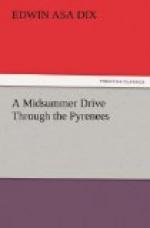* * * * *
The clouds are closing in, after granting us that glittering panorama, and the morning grows dull and dark. We explore the book-stores, and finally find the old Library in the upper story of the market-building. Here two of us at least pass a long and contentful forenoon.
V.
In fierce Count Gaston’s time, Bearn centred in Orthez, and Pau was but his hunting-box. Two hundred years later, Pau had become the focus, and Bearn and Foix not only, but French Navarre as well, were its united kingdom. Gaston’s Castle of Moncade had aged into history,—
“Outworn,
far and strange,
A transitory shame of long ago,”
and the hunting-box had grown in its turn to castle’s stature.
The world had brightened during the two centuries. Constantinople had fallen and the Renaissance came. Luther had posted his theses on the Wittemberg church door and the Reformation took root. Men were older than when Froissart lived and wrote. And this active province of Bearn kept pace; it opened quickly to the new influences, was alive to the changing zeitgeist. There remained the chivalric still,—and a trace of the barbaric,—as with the outer world; in short, in its faults and fervor’s, in its codes and standards, the sixteenth century is aptly summed up in Bearn-Navarre,—and Navarre in its famous Henry.
VI.
And so, on the following morning, we pass into the courtyard of his castle here at Pau with the feeling that in some sense we are evoking the shade of the era, not of the man. The feeling dies hard; but the robustious, business-like guide that herds us together with other comers, and shepherds us all briskly through the official round, goes very far toward killing it. There is little that one needs to remember of the successive rooms and halls; it is a confusion of polished floors, and vases, and tapestry, and porphyry tables, and the rest,—adorned and illumined by a voluble Gallic description. Later French kings have restored the old building, and stocked it with Paris furniture, and made it modern and comfortable. One is always divided in spirit over these restorations. The castle needed help painfully; it had been badly used by the Revolution; and it had been debased to a barrack by Napoleon’s troops, who “stabled their steeds in the courts and made their drunken revelry resound in the chambers of Marguerite of Angouleme.” Dismantled, half-roofless, its great halls, unsheltered and unsheltering, it was wasting fast under the elements into picturesque but irreparable ruin. And I suppose the pleasure of kings and the peace of utilitarians ought fairly to outweigh the disappointments of the touring impression-seeker.




